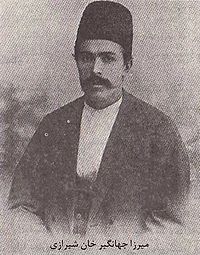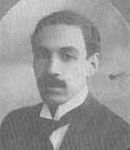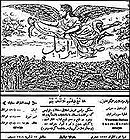- Jahangir-Khan Sur-e-Esrafil
-
Mirzā Jahāngir Khān (≈1870, or 1875, Shiraz — June 4, 1908, Tehran) (Persian: میرزا جهانگیرخان), mostly known as Mirzā Jahāngir Khān Shirāzi (شيرازى ) and Jahāngir-Khān-e Sūr-e-Esrāfil (جهانگیرخان صوراسرافیل), was an Iranian writer and intellectual, and a revolutionary during the Iranian Constitutional Revolution (1905–1911). He is best known for his bold editorship of the progressive weekly newspaper Sur-e Esrāfil,[1] of which he was also the founder. He was executed, at the age of 38, or 32, for his revolutionary zeal, following the successful coup d'état of Mohammad-Ali Shah Qajar in June 1908. His execution took place in Bāgh-e Shāh (باغشاه - The Garden of Shah) in Tehran, and was attended by Mohammad-Ali Shah himself. He shared this fate simultaneously with his fellow revolutionary Mirzā Nasro'llah Beheshti, better known as Malek al-Motakallemin.[2][3] It has been reported that immediately before his execution he had said "Long live the constitutional government" (Zendeh bād Mashrouteh) and pointed to the ground and uttered the words "O Land, we are [being] killed for the sake of your preservation [/protection]" (Ey Khāk, mā barāye hefz-e to koshteh shodim).[4]
Contents
Biography
Mirzā Jahāngir Khān was born to a relatively impoverished family from Shiraz.[5] In his youth he studied Persian literature, logic, philosophy and mathematics with the masters of these subjects in his birthplace Shiraz. He later moved to the capital city Tehran where he embarked on studying modern sciences at the élite school of Dar ol-Fonoon and some other centres of learning available in this city at his time. At the inception of the movement leading to the Constitutional Revolution, he joined a number of underground groups of revolutionaries and before long became one of the main pillars of the Revolution. He became a devotee of Hāj Sheikh Hādi Najmābādi.[6][7] Although it is known that Mirzā Jahāngir Khān was an Azali Bábí,[8] we do not know whether he became a Bábí in Shiraz, the cradle of Bábísm, or in Tehran.[9]
Through part of the legislative period of the First Majles, Mirzā Jahāngir Khān published the Sur-e Esrāfil weekly newspaper[10] as its Editor, receiving financial backing for this enterprise from Ghāsem Sur-e Esrāfil (قاسم صور اسرافيل), son of Mirzā Hasan Khān Tabrizi.[6] The first edition of Sur-e Esrāfil was published on Thursday 30 May 1907 (8 Khordād 1286 AH); one year and six days later, on Thursday 4 June 1908 (14 Khordād 1287 AH), Mirzā Jahāngir Khān was arrested and executed.[11] The circulation of Sur-e Esrāfil is said to have been approximately 20,000;[12][13] the number of printed copies of this newspaper has been as high as 24,000.[14] It was during this period that he overtly attacked the deposed Mohammad Ali Shah, a fact that did not pass unnoticed either by the latter or by his own devoted following, making him by equal measures both hated and loved.
One of the most celebrated literary figures of the time who contributed to Sur-e Esrāfil was Ali-Akbar Dehkhodā. His satirical political column, named Charand o Parand (Balderdash and Piffle)[15] and signed by such imaginary figures as Dakhoo, Dakhoo-Ali, Khar-Magas (Gad-fly), Ruz-Numeh-Chi (Journalist)[16] Gholām-Gedā Āzād Khān-e Ali-Allāhi,[17] Khādem ol-Foqarā Dakhoo-Ali Shāh,[18] Nokhod-e Hameh Āsh (Busy-Body),[19] Be'rah'neh-ye Khosh'hāl (The Happy Destitute),[20] proved both popular and controversial.[21]
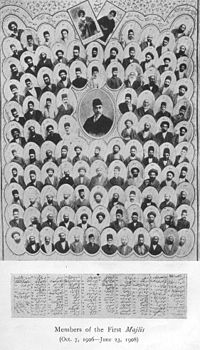 Members of the First Majles (October 7, 1906 — June 23, 1908). The central photograph is that of Mortezā Qoli Khan Sani od-Dauleh, the first Chairman of the First Majles. He had been for seven months the Finance Minister when he was assassinated on 6 February 1911 by two Georgian nationals in Tehran.[22]
Members of the First Majles (October 7, 1906 — June 23, 1908). The central photograph is that of Mortezā Qoli Khan Sani od-Dauleh, the first Chairman of the First Majles. He had been for seven months the Finance Minister when he was assassinated on 6 February 1911 by two Georgian nationals in Tehran.[22]
Further, Sur-e Esrāfil [21]
"played an important role in the political scene by supporting the Constitutional Movement and the paper ran many articles which were aimed at exposing the despotism, dependency, and corruption of the monarchy and the traditional views of the reactionary clergy. The paper was among the first to use ordinary language of the common people in place of the traditional didactic and flowery literary approach popular at the time among the literary circles and men of erudition. It identified with the masses and it could be understood by them and in this sense, it did not only play an important political role but also one of literary significance by establishing a new modern style of writing and journalism in Iran. Sur Esrafil [Sur-e Esrāfil] was popular newspaper among the people and was the first of its kind to be sold in busy street corners by children and petty city vendors and peddlers."
During the coup d'état of Mohammad-Ali Shah, the Russian-led Cossack Brigade, commanded by Colonel Vladimir Liakhov, shelled and subsequently laid siege to the seat of Majles.[23] Mirzā Jahāngir Khān, together with some deputies who had taken refuge inside the Majles compound, escaped through an opening in the siege and took refuge to the house of Mirzā Mohsen Khān Amin ad-Dauleh.[24] [25] Amin ad-Dauleh gave refuge to [Sayyed Abdollah] Behbahāni [26] (later, in 1910, to be assassinated for his pro-British activities), [Sayyed Mohammad] Tabataba'i and some others, however declined to give sanctuary to Mirzā Jahāngir Khān, Malek al-Motakallemin and two or three of other escapees. It is not known why Amin ad-Dauleh should have withheld vital support from these men, however both Mirzā Jahāngir Khān and Malek al-Motakallemin were Bábís and thus apostates in the eyes of many of their contemporaries. It is however conceivable that Amin al-Daouleh may have deemed that giving sanctuary to these men would prove fatal to his own life, given the fact that Mohammad-Ali Shah had come to consider in particular Malek al-Motakallemin as "among the most dangerous of his enemies."[27] Be it as it may, it has been reported that Amin ad-Dauleh not only declined to provide these men with sanctuary, but that he subsequently contacted Bāgh-e Shāh, by telephone, and betrayed both, following which Shah's soldiers arrested these men and executed them in Bāgh-e Shāh in the presence of Mohammad-Ali Shah himself.[6]
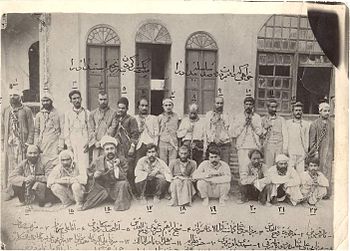 Some mistreated and shackled prisoners held in Bāgh-e Shāh, arrested following the successful coup d'état of Mohammad-Ali Shah. The left-most person standing (marked by 1) is Qāzi Qazvini, a Judge, who escaped from the Majles compound together with Mirzā Jahāngir Khān, Malek al-Motakallemin and some other Deputies. The person standing next to him is Soltān ol-Olamā', Editor of Ruh ol-Qods (The Holy Spirit) newspaper. The eighth person standing is Mirzā Mohammad-Ali Khān, Editor of Taraqqi (Progress) newspaper. The right-most person standing (marked by 13) is named as "Mirzā Mohammad-Ali, son of Hāji Malek al-Motakallemin".
Some mistreated and shackled prisoners held in Bāgh-e Shāh, arrested following the successful coup d'état of Mohammad-Ali Shah. The left-most person standing (marked by 1) is Qāzi Qazvini, a Judge, who escaped from the Majles compound together with Mirzā Jahāngir Khān, Malek al-Motakallemin and some other Deputies. The person standing next to him is Soltān ol-Olamā', Editor of Ruh ol-Qods (The Holy Spirit) newspaper. The eighth person standing is Mirzā Mohammad-Ali Khān, Editor of Taraqqi (Progress) newspaper. The right-most person standing (marked by 13) is named as "Mirzā Mohammad-Ali, son of Hāji Malek al-Motakallemin".
Later developments
Following the executions of Mirzā Jahāngir Khān and Malek al-Motakallemin, Mohammad-Ali Shah's Cossacks abandoned their bodies in a moat outside the walls of Bāgh-e Shāh. On this news reaching their friends, at night-time they buried the bodies of these men in the same or a nearby location. Following the overthrow of Mohammad-Ali Shah Qajar, these burials received some measure of official recognition and the graves were marked by stones engraved by the names of the men.[28] With the extension of Tehran, this part of the city later became a residential area and the family of Malek al-Motakallemin built a house whose walls enclosed the graves; it became the residential home of one of Malek al-Motakallemin's sons, Asado'llah Malek-Zādeh. This house is now adjacent to Loqman od-Dauleh Adham General Hospital on Kamāli Street.[29] The planned enlargement of this hospital foresees absorption of this house into the hospital; the parking area of the hospital has been named as a possible location of which the grounds of this house may become a part.[30] The extant family of Malek al-Motakallemin have expressed their willingness to provide for the funds necessary for the preservation of the graves. The neglect by the National Heritage Ministry of this historical house, leading to the planned extension of Loqman od-Dauleh Adham General Hospital into the grounds of this house reaching such an advanced stage, is most regrettable; one is painfully reminded of the construction of the Sivand Dam and the inundation of the Bolaghi Gorge.[30]
 Mirzā Jahāngir Khān
Mirzā Jahāngir Khān
A statue of Malek al-Motakallemin — made by the same artist, Abol-Hasan Khan Sadiqi, and from the same material and in the same dimensions as the statue of Ferdowsi (see Tehran's Ferdowsi Square) was during the Pahlavi régime removed from the Hasan Abad Square (after the Iranian Revolution of 1979 renamed "31 Shah'rivar Square") and put in the care of Parks Authorities who stored it inside the headquarters of the organisation; it is believed that the Palace was opposed to the public display of this statue.[30] In 1999 this statue was transferred from this location to a storehouse of The City Park (Park-e Shahr) of Tehran.[30] In April 2006, this statue was declared as missing and this remains the case to this date.[30] It is ironic that while subsequent to the Iranian Revolution it was decided to erect Malek al-Motakallemin's statue at his graveside,[30] not only has this statue in the meantime gone missing, but also, as it stands, the very continuation of the existence of this graveside into future seems now more uncertain than ever before.
Notes and references
- ^ Sur-e Esrāfil means Trumpet of Esrāfil, Esrāfil being, by the Islamic traditions, the God's favourite angel whose trumpeting will announce the Day of Judgement, or the Day of Resurrection (Arabic: يوم القيامة). Compare with: "Behold, I shew you a mystery; We shall not all sleep, but we shall all be changed, In a moment, in the twinkling of an eye, at the last trump; for the trumpet shall sound, and the dead shall be raised incorruptible, and we shall be changed." (I Corinthians, ch. 15, verses 51 and 52).
- ^ Sur-e Esrāfil (Mirza Jahangir Khan Shirazi), Personalities During the Constitutional Revolution and In the Decennia Before and After ("Chehre-hāye Dorān-e Mashrutiaat va Dahe-ye [sic] Ghabl va Ba'ad as Ān"), edited by Sinā Yektā (سينا يكتا), Roshangari (in Persian).
- ^ Both Mirzā Jahāngir Khān and Malek al-Motakallemin were Azali Bábís. See: Nikki R. Keddie, with a section by Yann Richard, Modern Iran - Roots and Results of Revolution, updated edition (Yale University Press, New Haven, 2003), pp. 70, 179 and 180.
- ^ Mirza Jahangir Khan Sur-e Esrafil, 19 July 2008, YouTube: [1] (7 min 11 sec). It is important to note that koshteh shodim is in the past tense and its use (by Mirza Jahangir Khan, while apparently still alive), along with his use of "we", instead of "I" (unless he had been referring to both himself and the other fellow prisoners), has a dramatic effect on the hearers who know Persian. Thus the translation "we are [being] killed" amounts to a compromise, as "we were killed" would feel odd and out of place in English.
- ^ Mirzā Jahāngir Khan's father's name is Rajab-Ali Shirāzi. It has been mentioned that as a child Mirzā Jahāngir Khan was put in the care of his aunt. See: Farhang va Honar (Culture and Art) [2]. Here the age of Mirzā Jahāngir Khan at his death is given as 34. Two further details given here are, firstly, that 32 issues of Sur-e Esrāfil were published under the editorship of Mirzā Jahāngir Khan and, secondly, that after the murder of Mirzā Jahāngir Khan, Sur-e Esrāfil was continued to be published by Ali-Akbar Dehkhoda and Hasan Taqizadeh outside Iran. In Ali Akbar Dehkhoda, Iran Chamber Society, one reads that: "While in exile [following Mohammad-Ali Shah's coup d'état], first in Paris and then to [sic] Switzerland, Dehkhoda with the aid of other Iranian exiles in Paris such as Abolhassan Pirnia and Mo'azed al-Saltaneh published three additional issues of Sur-Esrafil [Sur-e Esrafil] in Yverdon, Switzerland, which according to [Abdollah] Mostofi were sent to and circulated in Iran."
- ^ a b c Sur-e Esrāfil (Mirza Jahangir Khan Shirazi), ibid.
- ^ Hāj Sheikh Hādi Najmābādi (حاج شيخ هادي نجم آبادي) is known to have been one of the main patrons of the Roshddieh School in Tabriz. See Mahmud Hakimi, in Pioneers of Education: Mirza Hasan Roshddieh, founder of modern schools in Iran, Jazireh Danesh (in Persian).
- ^ Nikki R. Keddie, ibid., pp. 70, 179 and 180.
- ^ According to Mangol Bayat (p. 43), Hāj Sheikh Hādi Najmābādi was "a mojtahed [a clergyman practising religious jurisprudence] declared heretical for his alleged Azali Babist sympathies." It seems therefore very likely that Mirzā Jahāngir Khan became a Bábí in Tehran where Hāj Sheikh Hādi Najmābādi gave private and informal lectures at the time. Mangol Bayat, Iran’s First Revolution: Shi’ism and the Constitutional Revolution of 1905–1909, Studies in Middle Eastern History, 336 p. (Oxford University Press, 1991). ISBN 019506822X
- ^ Mirza Jahangir Khan-e Sur-Esraafil [sic] (in Persian), Rozaneh Magazine (September - October 2003) [3]. Here the age of Mirzā Jahāngir Khān at the time of his death is indicated as having been 32, implying that he must have been born in 1875 or 1876. The same text provides two further relevant pieces of information, namely that, firstly, Mirzā Jahāngir Khān had had the opportunity to take refuge in the compound belonging to the British Legation in Tehran, however he had expressedly rejected to use this option, and secondly, Mirzā Jahāngir Khān's execution was effected through strangling and stabbing in his heart: first two executioners affixed two separate ropes to his neck and pulled these in opposite directions until blood flew from his mouth, upon which a third executioner stabbed him is his heart.
- ^ Mirza Jahangir Khan-e Sur-Esraafil [sic] (in Persian), Rozaneh Magazine, ibid.
- ^ Ali-Akbar Dehkhoda, Persian Language & Literature, Iran Chamber Society.
- ^ The writer of these lines has encountered a single document that indicates that the Sur-e Esrāfil newspaper was printed in Shiraz. This information needs to be verified since it appears very unlikely to be correct, in view of the fact that at the time both the Editor and the main contributors to this newspaper were residents of Tehran; Shiraz is located 919 kilometres (571 mi) south of Tehran and given the state of the public transportation of hundred years ago, one can have serious doubts as to whether it could have been feasible to print a weekly newspaper at such a distance from its Editor.
- ^ A.-A. Sa'īdī Sirjāni, Dehkhodā, Encyclopaedia Iranica, [4].
- ^ Dehkhodā's Charand o Parands have been collected and published in book format; see: Charand o Parand (in Persian) by Ali-Akbar Dehkhodā (Afrasiyab, Tehran, 2002) - ISBN 9646962904. Very recently even an audiobook of this collection has been brought to market; see: Ketab-e Gooya.
- ^ Ruz-Numeh-Chi is the vulgar pronunciation of Ruz-Nāmeh-Chi.
- ^ A compound name, consisting of incompatible sub-names: Gholām-Gedā meaning 'Servant-Beggar', Āzād Khān meaning approximately 'Sir Sovereign'. Ali-Allāhi is a minority sect within Islam that attributes godhead to Imam Ali.
- ^ Meaning 'Servant of the Poor, King Dakhoo-Ali'. Note the juxtaposition of 'Servant' and 'King'.
- ^ The literal translation of Nokhod-e Hameh Āsh is 'The Pea of All Soups'.
- ^ The literal meaning of Be'rah'neh is 'Naked'. Someone is said to be Be'rah'neh if that person is unable to provide in his or her most basic material needs. Hence the translation 'Destitute'.
- ^ a b Ali-Akbar Dehkhoda, Persian Language & Literature, ibid.
- ^ W. Morgan Shuster, The Strangling of Persia, 3rd printing (T. Fisher Unwin, London, 1913), pp. 48, 119, 179. According to Shuster (p. 48), "Five days later [measured from February 1st] the Persian Minister of Finance, Saniu'd-Dawleh was shot and killed in the streets of Teheran by two Georgians, who also succeeded in wounding four of the Persian police before they were captured. The Russian consular authorities promptly refused to allow these men to be tried by the Persian Government, and took them out of the country under Russian protection, claiming that they would be suitably punished."
See also: Mohammad-Reza Nazari, The retreat by the Parliament in overseeing the financial matters is a retreat of democracy, in Persian, Mardom-Salari, No. 1734, 20 Bahman 1386 AH (9 February 2008), [5]. - ^ "After an unsuccessful attempt on his [Mohammad-Ali Shah's] life, the shah achieved, following a failed coup, a successful coup d'état with the help of the Russian-led Cossack Brigade in June 1908. The majles was closed and many popular nationalist leaders, especially those of more advanced views, were arrested and executed. The radical preachers Jamal ad-Din Esfahani (caught while trying to flee), Malek al-Motakallemin and the editor of Sur-e Esrāfil, Mirza Jahangir Khan (the last two had Azali Bábí ties), were among those killed. Taqizadeh along with some others found refuge in the British Legation, whence he went abroad for a time." Nikki R. Keddie, ibid., p. 70. Jamal ad-Din Esfahani Sayyed Jamal-al-Din Esfahani is the father of the celebrated Iranian writer Mohammad-Ali Jamalzadeh.
- ^ The individuals who together with Mirzā Jahāngir Khān escaped, through an opening in the wall of the seat of Majles, to the Amin ad-Dauleh Park (پارك امين الدوله), were the following: [Sayyed Abdollah] Behbahāni (بهبهانى), [Sayyed Mohammad] Tabātabā'i (طباطبايى) [father of Sādeq Tabātabā'i, Editor of Ruz'nāmeh-ye Majles (The Majles Newspaper)], [?] Khoi (خويى), [?] Hakim ol-Molk (حكيم الملك), [?] Mostashār ad-Dauleh (مستشارالدوله), [?] Momtāz ad-Dauleh (ممتازالدوله), [?] Bahā ol-Vā'ezin (بهاالواعظين), [?] Qāzi Qazvini (قاضى قزوينى), Haj Mirzā Ebrahim Āghā (حاج ميرزا ابراهيم آقا), Davood Khān Aliābādi (داوودخان على آبادى), Ali-Akbar Ardāghi (على اكبر ارداقى), and Malek al-Motakallemin (ملك المتكلمين) [father of Mehdi Malekzadeh, the historian of the Constitutional Revolution]. See Sur-e Esrāfil (Mirza Jahangir Khan Shirazi), ibid.
- ^ Mirzā Mohsen Khān Amin ad-Dauleh (Amin ad-Dauleh II) is the son of Mirzā Ali Khān Amin ad-Dauleh, the liberal and reformist Chief Minister of Mozaffar ad-Din Shah during 1897-1898, and the father of the future Prime Minister of Iran Dr Ali Amini. Mirzā Mohsen Khān Amin ad-Dauleh was married to Fakhr ad-Dauleh, Princess Ashraf, daughter of Mozaffar al-Din Shah and Hazrat-e Oliah. Hazrat-e Oliah is the sister of Najm al-Saltaneh, mother of Iran's other future Prime Minister Dr Mohammad Mossadeq. Mirzā Mohsen Khān had a brief spell in government as minister of Post and Telegraph. For the genealogical details see: Shajareh-nameh Project: Amini-Qajar.
- ^ Sayyed Abdullah Behbahani
- ^ "In Tehran, the two [Malek al-Motakallemin and Sayyed Jamal ad-Din Esfahani] became major preachers of the revolutionary and constitutional cause, explaining it in familiar Muslim terms emphasizing such Islamic concepts, particularly central in Shi'ism, as Justice and Oppression. Mohammad-Ali Shah considered them among the most dangerous of his enemies and had them both killed in 1908, as he did the editor of Sur-e Esrāfil, Mirzā Jahāngir Khān, also of Bábí background." Nikki R. Keddie, ibid., pp. 179 and 180.
- ^ Ne'mat Ahmadi, Let us prevent destruction of the burials of Sur-e Esrāfil and Malek al-Motakallemin, in Persian, Āftāb, Saturday, April 21, 2007. [6]
- ^ The address of this house is: Kamāli Street, Makhsus Street, Shahid Ebrahimi Avenue. Shadid Ebrahimi Avenue is a cul-de-sac and the Malek-Zādeh house is identified as the last house on the left (satellite photograph of the location – move the arrow around the location marked by "+"). See: Ne'mat Ahmadi, ibid.
- ^ a b c d e f Ne'mat Ahmadi, ibid.
Further reading
- John Foran, The Strengths and Weaknesses of Iran’s Populist Alliance: A Class Analysis of the Constitutional Revolution of 1905 - 1911, Theory and Society, Vol. 20, No. 6, pp. 795–823 (December 1991). JSTOR
- Nikki R. Keddie, with a section by Yann Richard, Modern Iran - Roots and Results of Revolution, updated edition (Yale University Press, New Haven, 2003). ISBN 0-300-09856-1
- Mangol Bayat, Iran’s First Revolution: Shi’ism and the Constitutional Revolution of 1905–1909, Studies in Middle Eastern History, 336 p. (Oxford University Press, 1991). ISBN 019506822X
- Ahmad Kasravi, Tārikh-e Mashruteh-ye Iran (تاریخ مشروطهٔ ایران) (History of the Iranian Constitutional Revolution), in Persian, 951 p. (Negāh Publications, Tehran, 2003), ISBN 9643511383. This book is also available in two volumes, published by Amir Kabir Publications in 1984. Amir Kabir's 1961 edition is in one volume, 934 pages.
- Ahmad Kasravi, History of the Iranian Constitutional Revolution: Tarikh-e Mashrute-ye Iran, Volume I, translated into English by Evan Siegel, 347 p. (Mazda Publications, Costa Mesa, California, 2006). ISBN 1568591977
- Mehdi Malekzādeh, Tārikh-e Enqelāb-e Mashrutyyat-e Iran (تاريخ انقلاب مشروطيت ايران) (The History of the Constitutional Revolution of Iran), in 7 volumes, published in 3 volumes, 1697 p. (Sokhan Publications, Tehran, 2004 — 1383 AH). ISBN 964-372-095-0 Note: Mehdi Malekzādeh is the son of Malek al-Motakallemin.
- Mehdi Malekzādeh, Zendegi-ye Malek al-Motakallemin (زندگانى ملك المتكلمين) (Life of Malek al-Motakallemin), 308 p. (Ali-Akbar El'mi Publications, Tehran, 1946 — 1325 AH). OCLC 15498702
External links
- Ahmad Seyf, Journalism at the time of the Constitutional Revolution (روزنامه نگاری در عصر مشروطیت), Sur-e Esrāfil: A Spark in Darkness (صوراسرافیل: جرقه ای در تاریکی), in Persian, Niaak — Notes of Ahmad Seyf, Monday, July 3, 2006 on Blogspot.com
- Moghdad Rouhani, Commissioner of The Secret Society in Najaf (مامور «انجمن سري» در نجف), in Persian, Zamāneh Monthly, No. 35, 1384/2005. Re-published in Bāshgāh-e Andi'sheh (The Contemplation Club). Bashgah.net
- Naser od-Din Parvin, Mirza Jahangir Khan Shirazi (Sur-e Esrāfil), Thursday, July 27, 2006 on BBC
- Mirza Jahangir Khan Sur-e Esrafil, July 19, 2008 on YouTube (7 min 11 sec).
- M. Janbeglou, a photograph of Mirza Jahangir Khan's bust held at House of Constitution (Khāneh-ye Mashtrouteh) in Tabriz on Webshots.com
See also
Categories:- Iranian journalists
- Iranian writers
- People from Shiraz
- 1870 births
- 1875 births
- 1908 deaths
Wikimedia Foundation. 2010.

